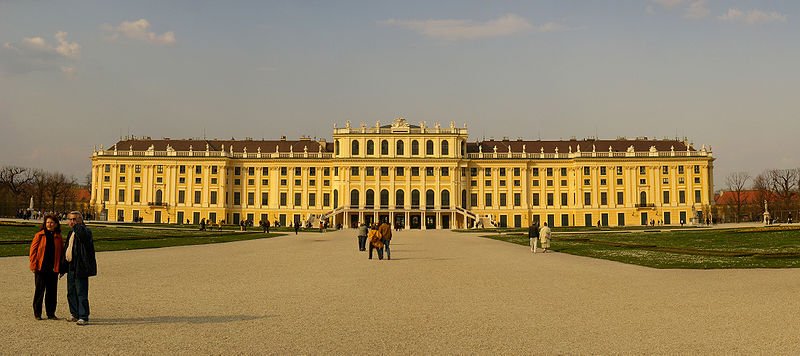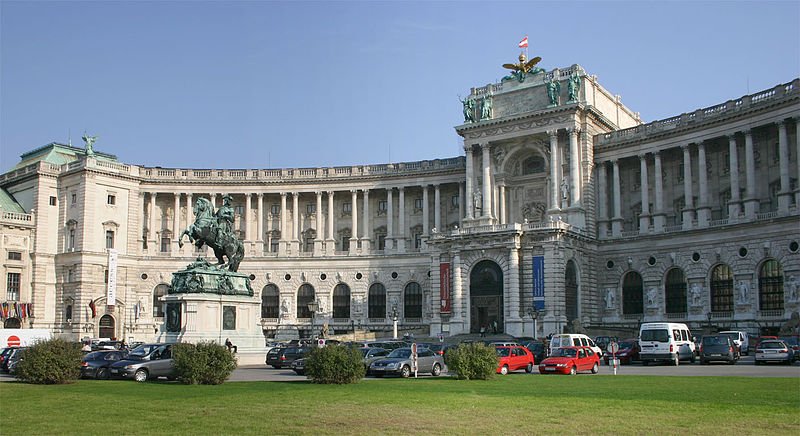 Heldenplatz, with the Neue Burg in Vienna
Heldenplatz, with the Neue Burg in ViennaSource: https://commons.wikimedia.org/wiki/File:Wien_Hofburg_Neue_Burg_Heldenplatz.jpg
Author: Peter Gerstbach

Vienna (Wien) is the capital and largest city in Austria. It covers 414.89 sq km (160.2 sq mi) and has a population of 1.7 million people (2011 estimate), within a metropolitan area of 2.4 million people. Vienna is on the eastern part of Austria at an elevation from 151 m (495 ft) in Lobau to 542 m (1,778 ft) in Hermannskogel. It observes the Central European Time, which is an hour ahead of Coordinated Universal Time (UTC+1) and two hours ahead during Daylight Saving Time of summer.
Vienna is located in the Vienna Basin, on the eastern edge of the Alps. It experiences a transition between the oceanic climate and the humid continental climate. The warmest months are July and August, when the average temperature rises to 25.6°C (78.1°F) or more. June is the wettest month in Vienna, with 70.2 mm (2.764 in) of precipitation.
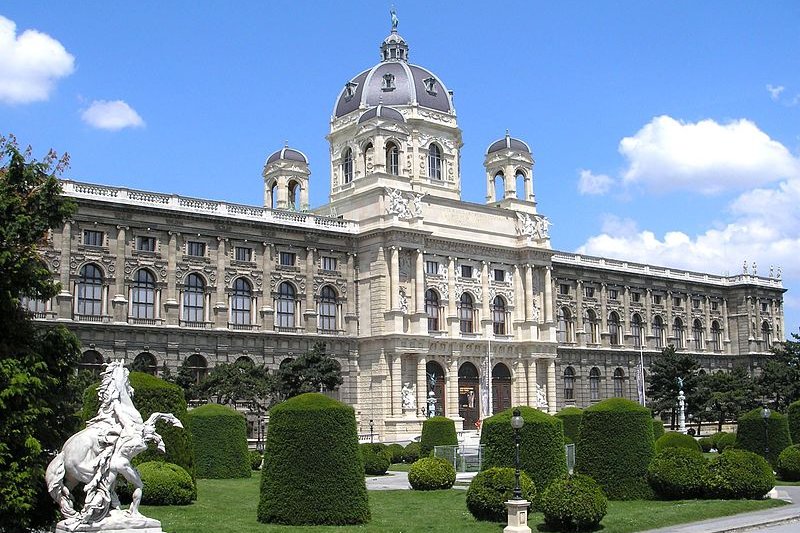 Naturhistorisches Museum, Vienna
Naturhistorisches Museum, ViennaSource: https://commons.wikimedia.org/wiki/File:Naturhistorisches_Museum_Vienna_June_2006_241.jpg
Author: Gryffindor

Vienna is renowned throughout the Western world for its association with the theater, opera, classical music and fine arts. The city has some of the best theaters within the German-speaking world. The city (along the Salzburg) has produced a number of famous classical composers such as Johann Strauss, Wolfgang Amadeus Mozart and Franz Schubert.
The city of Vienna has a rich collection of historical buildings exhibiting different architectural styles ranging from classicist to modern. It also has some of the best examples of Art Nouveau architecture in the world.
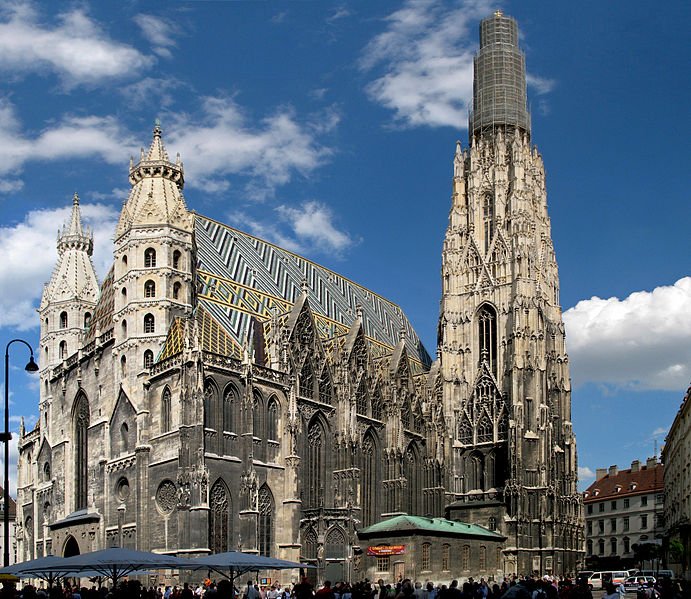 Stephansdom, or St Stephens's Cathedral in Vienna
Stephansdom, or St Stephens's Cathedral in ViennaSource: https://commons.wikimedia.org/wiki/File:0181-0183a_-_Wien_-_Stephansdom.jpg
Author: Andrew Bossi

While the area around present-day Vienna has been inhabited since 500 BC, the city itself traces its history to a Roman fortified settlement called Vindobona, established in 15 BC. It grew in importance in the Middle Ages, when it became the home of the Babenberg dynasty (AD 976-1248), and the resident city of the Habsburg dynasties. This led to it becoming the capital of the Holy Roman Empire.
Vienna was almost captured by the Ottoman armies, once in the Siege of Vienna in 1529 and again in the Battle of Vienna in 1683. In 1804, it became the capital of the Austrian Empire and from 1867, the capital of the Austro-Hungarian Empire.
In 1938, Vienna lost its status as capital when the Nazis captured Austria and annexed it into Nazi Germany. Its status as capital was only restored in 1945, when Vienna fell to British, American and Soviet offensives. After the war the city was divided into the British, American, French and Soviet sectors, similar to Berlin, except that in Vienna's case, the Soviets eventually pulled out in 1955.
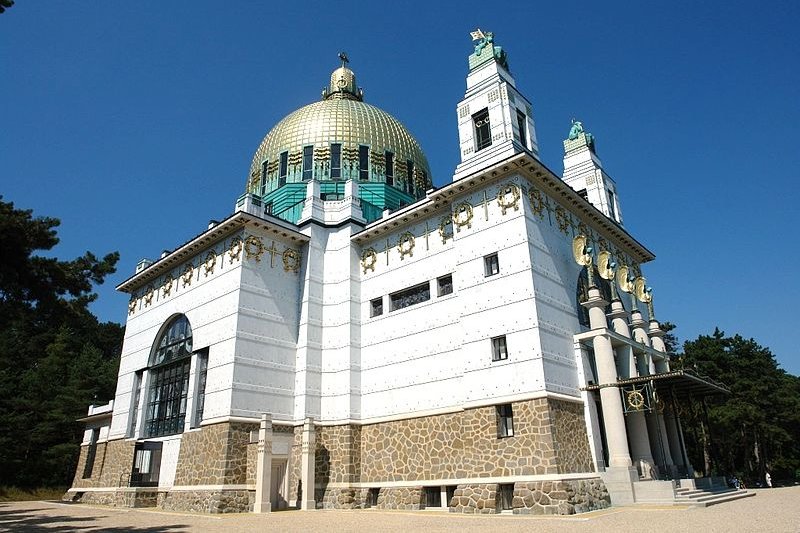 Kirche am Steinhof, a beautiful church in Vienna
Kirche am Steinhof, a beautiful church in ViennaSource: https://en.wikipedia.org/wiki/File:Kirche_am_Steinhof_2007.jpg
Author: A. Fernandez Fernandez

Visiting Vienna
The Vienna International Airport (VIE) is the biggest airport in Austria. It is the base of Austrian Airlines and budget carrier Niki. Arriving visitors have an option of taking the S-Bahn (commuter train), the City Airport Train, the Vienna AirportLines Bus and taxi.Both the S-Bahn and the City Airport Train take you to the same destination: the Wien-Mitte Station, on the southern part of downtown Vienna, from where you can transfer to other trains. The S-Bahn makes the trip in 25 minutes for €3.60; the City Airport Train in 15 minutes for €10.
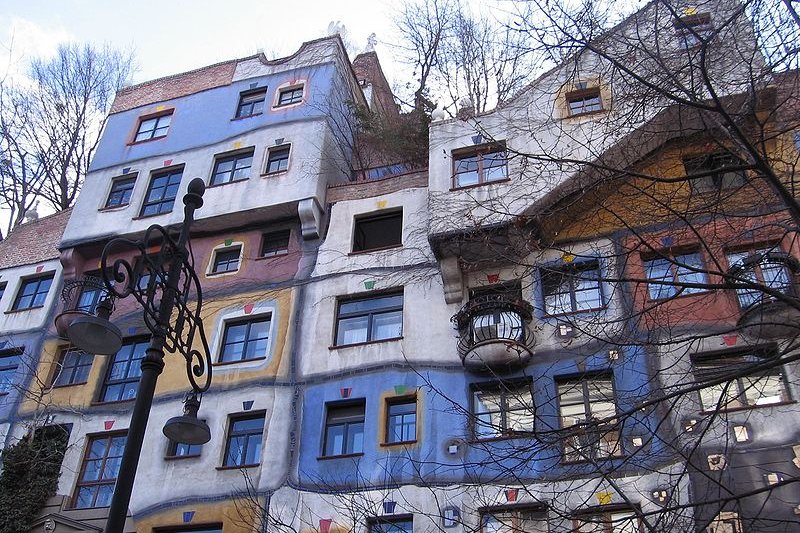 Hundertwasser-Haus, an architectural icon in Vienna
Hundertwasser-Haus, an architectural icon in ViennaSource: https://commons.wikimedia.org/wiki/File:WienIMG_5106.jpg
Author: Zeljko

The airport bus takes you from airport to different stops in Vienna. You can pay by cash direct to the operator. One way fare is €6, round-trip fare is €11. Taxis will take you anywhere in Vienna. Expect the fare to be between €25 to €30.
Exploring Vienna
As a tourist, you are most likely to explore the inner part of Vienna, which are all within the same transportation zone. The city center itself is quite compact, and exploring on foot would be the best option. For further distances, the best option is to get tickets that offer unlimited rides, valid on all the trains and trams. There are a few types depending on how long you are spending in Vienna. There's the Einkauskarte or "shopping ticket", valid from 8:00 am to 8:00 pm for €4.60. Then there's also the 24-hour ticket for €5.70, 48-hour for €10.00, 72-hour for €13.60, and one-week for €14 (valid Mon through Sun only).Historic Centre of Vienna
The Historic Centre of Vienna was designated with World Heritage status during the 25th session of the World Heritage Committee, which met in Helsinki, Finland, on 11-16 December, 2001. It encompasses an area of 371 hectares surrounded by a buffer zone of 462 hectares. The World Heritage Committee recognises the Historic Centre of Vienna for its outstanding architectural qualities, which exhibits the European cultural and political development in the Middle Ages, the Baroque period and the Gründerzeit. Also, it celebrates Vienna's role as the musical capital of Europe, a position acknowledged since the 16th century.Within the core zone of the World Heritage Site are numerous medieval heritage buildings. These include the Schottenkloster, which is the oldest monastery in Austria, the churches of Maria am Gestade, Michealerkirche, Minoritenkirche, Minoritenkloster, and St Stephen's Cathedral.
 Stephansdom, Vienna
Stephansdom, ViennaSource: https://commons.wikimedia.org/wiki/File:0181-0183a_-_Wien_-_Stephansdom.jpg
Author: Andrew Bossi

World Heritage Site in Vienna
Palace and Gardens of Schönbrunn
DetailsSights in the Historic Centre of Vienna
Here's a list of sights, tourist attractions and places of interest within the core zone of the Vienna World Heritage Site.St Stephen's Cathedral, Vienna
St Stephen's Cathedral (Stephansdom), located right at the heart of Vienna, is the mother church of the Archdiocese of Vienna and the seat of the Archbishop of Vienna. It is dedicated to St Stephen, the first Christian martyr. There has been a church here since 800 years ago, though the present building is in the late-Gothic style.
The Cathedral Museum (Diözesanmuseum) has a large collection of religious paintings and sculptures. Many of these were donated to the cathedral by Duke Rudolf IV. Among the must-see's at the museum include the portrait of the duke, and the Erlacher Madonna, a life-size sculpture of the Madonna and Child.
St Peter's Church, Vienna
St Peter's Church (Peterskirche), is one of the oldest churches in Vienna. It is believed to have been founded in 792AD by Charlemagne. While that is based on a marble relief on the church's façade, there is evidence that the site has been a Roman basilica since the 12th century.
Graben, Vienna
Graben is a pedestrianised street. It is one of the most fashionable shopping areas in Vienna. You can find lots of restaurants and cafés here. Of interest are two identical fountains here, the St Joseph Fountain and the St Leopold Fountain.
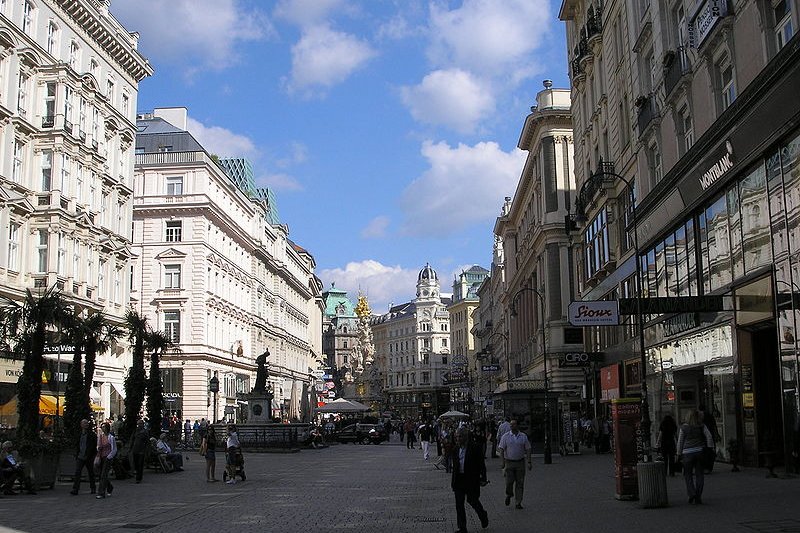 Graben, the famous shopping street in Vienna
Graben, the famous shopping street in ViennaSource: https://commons.wikimedia.org/wiki/File:Graben_Vienna_June_2006_282.jpg
Author: Gryffindor

Mozart's Vienna Residence
Mozart's Vienna residence at Domgasse 5 is where the famous composer lived with his family from 1784-1787. It was restored in 2006, and now exhibits Mozart memorabilia on the two upper floors as well as at Mozart's first floor apartment.
Church of the Teutonic Order of St. Elisabeth, Vienna
The Church of the Teutonic Order of St Elisabeth (Deutschordenskirche St Elisabeth) at Singerstraße 7 is a Gothic church built by the knights of the Teutonic Order in the 15th century. The knights had arrived in Vienna in the 13th century, but only the tower of their original church survivies.
Franciscan Church, Vienna
The Franciscan Church, or Franziskanerkirche, is sited where originally there was a house built by wealthy citizens of Vienna for the rehabiliation of prostitutes. The present building dates to 1601-11. It was designed by Bonaventura Daum in the South German Renaissance Style.
Dr.-Ignaz-Seipel-Platz, Vienna
Dr.-Ignaz-Seipel-Platz is one of the loveliest squares in Vienna. Among the buildings around the square is the Rococo-style Austrian Academy of Sciences (Österreichische Akademie der Wissenschaften) and the Jesuit Church (Jesuitenkirche), built in the High Baroque style.
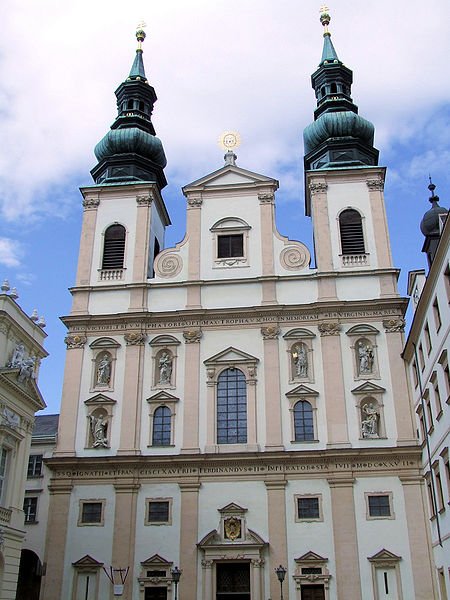 Jesuitenkirche, the Jesuit church at Dr Ignaz Seipel-Platz in Vienna
Jesuitenkirche, the Jesuit church at Dr Ignaz Seipel-Platz in ViennaSource: https://commons.wikimedia.org/wiki/File:Jesuitenkirche,_Wien2.jpg
Author: Werckmeister

Dominican Church, Vienna
The Dominican Church, or Dominikanerkirche, at Postgasse 4, was built between 1631 and 1674 for the Dominican monks who first came to Vienna in 1226, at the invitation of Duke Leopold VI. The church has a richly ornate interior.
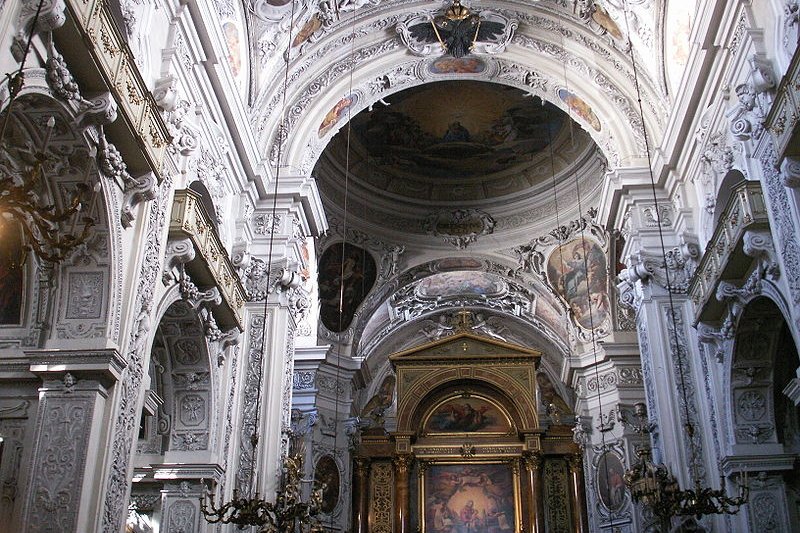 The beautifully ornate interior of Dominikanerkirche in Vienna
The beautifully ornate interior of Dominikanerkirche in ViennaSource: https://commons.wikimedia.org/wiki/File:Dominikanerkirche_Vienna1.jpg
Author: Welleschik

Austrian Museum of Applied Arts, Vienna
The Austrian Museum of Applied Arts (Österreichische Museum für Angewandte Kunst) at Stubenring 5 is the first museum of its kind in Europe. It was established in 1864, and houses the collection of Wiener Werkstätte, workshops that are famous for their design.
Urania, Vienna
Urania is a round building with a distinctive dome built in 1910 following the designs by Max Fabian. It houses Vienna's oldest educational establishment that is not a school. It is also the home of a cinema, the Urania Kino, and a planetarium.
Schwedenplatz, Vienna
Schwedenplatz, or Swedish Square, is a landing place by the banks of the Danube Canal where one can go on pleasure cruises. In Laurenzberg in Schwedenplatz, you can see the remains of the old town wall with metal rings used to tie up the horses.
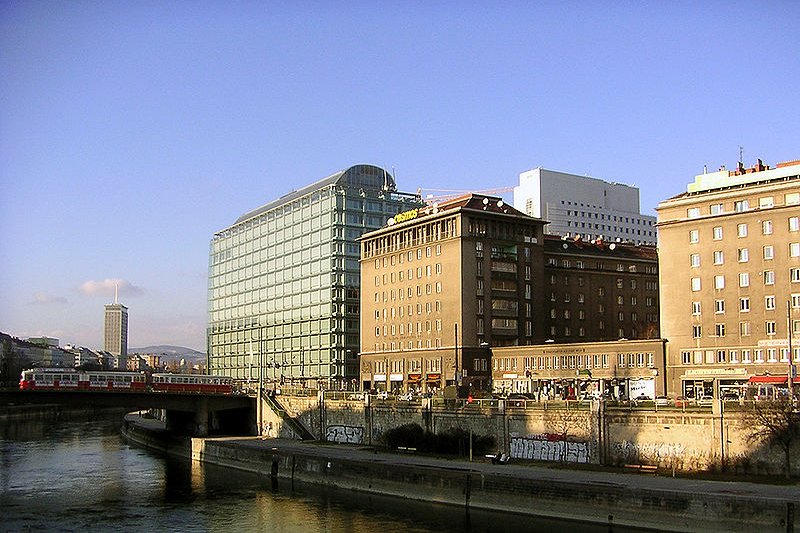 Schwedenplatz, at the banks of the Danube Canal in Vienna
Schwedenplatz, at the banks of the Danube Canal in ViennaSource: https://commons.wikimedia.org/wiki/File:Donaukanal-schwedenplatz.jpg
Author: Werckmeister

St Rupert's Church, Vienna
St Rupert's Church (Ruprechtskirche) sits on an escarpment overlooking St Rupert's Square (Ruprechtsplatz). It is believed to be Vienna's oldest church, founded in 740 AD by the disciples of St Rupert, the bishop of Salzburg.
Jewish Quarter, Vienna
The Jewish Quarter was formerly a ghetto area where the Jews in Austria had their synagogue, hospital, school and bathhouses. Today it has become a place with discotheques and kosher restaurants.
Maria am Gestade, Vienna
Maria am Gestade is one of the oldest churches in Vienna. The present building dates to the 13th century. It has beautiful stained glass panels at the main altar. Its steeple rises to a height of 50 meters.
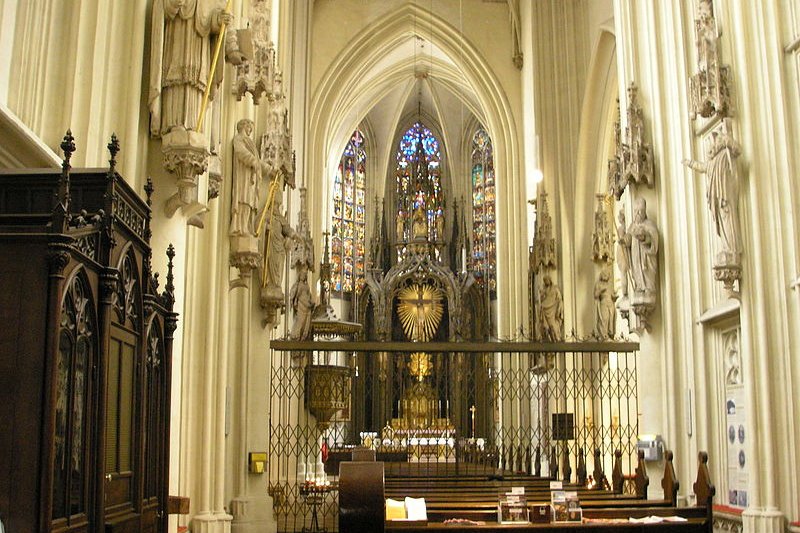 View of the interior of Maria am Gestade in Vienna
View of the interior of Maria am Gestade in ViennaSource: https://commons.wikimedia.org/wiki/File:Maria_am_Gestade_interior,_Vienna_5.jpg
Author: Gryffindor

Old Town Hall of Vienna
The Old Town Hall or Altes Rathaus originally belonged to the brothers Otto and Heymo Neuburg, who were involved in the rebellion against the Habsburg. Prince Friedrich the Fair confiscated their property and gave it to the town, where it served as the Town Hall until 1883.
Hoher Markt, Vienna
Hoher Markt dates back to Roman times, making it the oldest square in Vienna. The foundation of Roman military structures were discovered here, and have since become a tourist attraction. Another sight here is the Anker Clock, designed in 1911 by Franz von Matsch.
Bohemian Court Chancellery, Vienna
The Bohemian Court Chancellery (Böhmische Hofkanzlei) dates back to when Emperor Ferdinand II, who was also king of Bohemia, moved his administration to Vienna. The building was designed by Johann Bernhard Fischer von Erlach. Austrian emperors ruled Bohemia from here.
Schulhof, Vienna
Schulhof is a small alley in Vienna. It links the Am Hof square with the Baroque residential neighbourhood of Kurrentgasse. The Clock Museum (Uhr-Museum), with all types of clocks going back to the 15th century, is the main sight here.
Am Hof Square, Vienna
Am Hof square is the place where the medieval princes of Vienna had their residences. The name "am Hof" means "by the Court". Among the attractions here include the Chapel of the Nine Angel Choirs. There are also a number of interesting buildings around the square including the Collalto Palace, where six-year-old Mozart gave his first performance.
Freyung Square, Vienna
Freyung is a square whose name means "right of sanctuary". This is because fugitives are given sanctuary at the Schottenkirche (Scottish church), which it today located at No. 6. Other buildings at Freyung includes the Baroque Harrach Palace, the Kinsky Palace and the Porcia Palace.
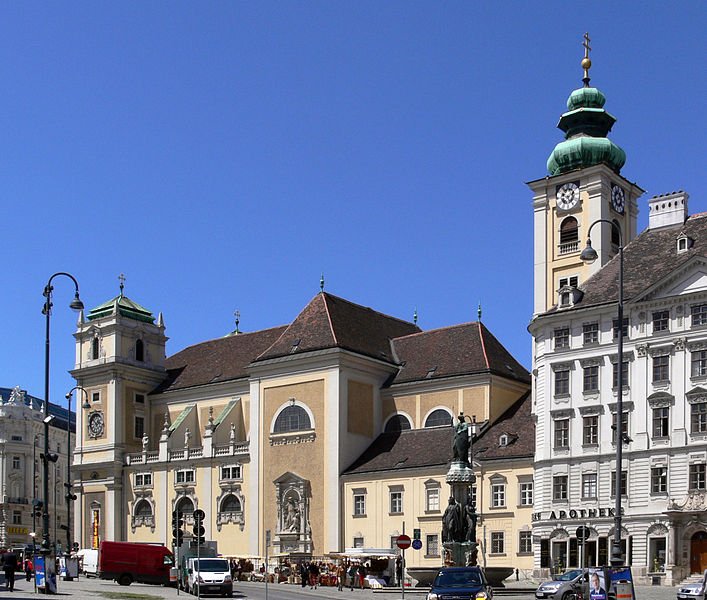 View of Freyung Square in Vienna with the church Schottenkirche
View of Freyung Square in Vienna with the church SchottenkircheSource: https://commons.wikimedia.org/wiki/File:Wien_Freyung_Schottenstift.jpg
Author: Andreas Praefcke

Herrengasse, Vienna
Herrengasse was once the choice address for the nobility during medieval times. Today it is occupied mostly by government offices. Among the buildings here is the Landhaus, which houses the provincial government of Lower Austria.
Minoritenplatz, Vienna
Minoritenplatz is a square. Its most prominent sight is the Minoritenkirche, the church originally built for the Minor Friars in 1224. The present structure is a Franciscan church built in the 14th century.
Michaelerplatz, Vienna
The Michaelerplatz is a square facing Michaelertor, the main entrance to the imperial residence. On either sides of Michaelertor are wall fountains built in the 19th century. The St Michael's Church (Michaelerkirche) used to be the parish church of the imperial court.
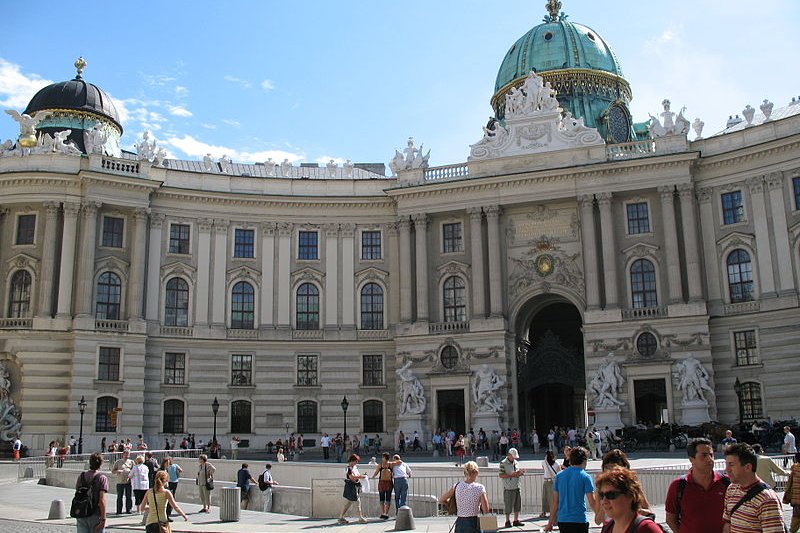 Michaelerplatz in Vienna
Michaelerplatz in ViennaSource: https://commons.wikimedia.org/wiki/File:IMG_0171_-_Wien_-_Michaelerplatz.JPG
Author: Andrew Bossi

Volksgarten, Vienna
The Volksgarten (People's Garden) is a garden which was created after Napolen had the city walls demolished. The garden was laid out in the French style.
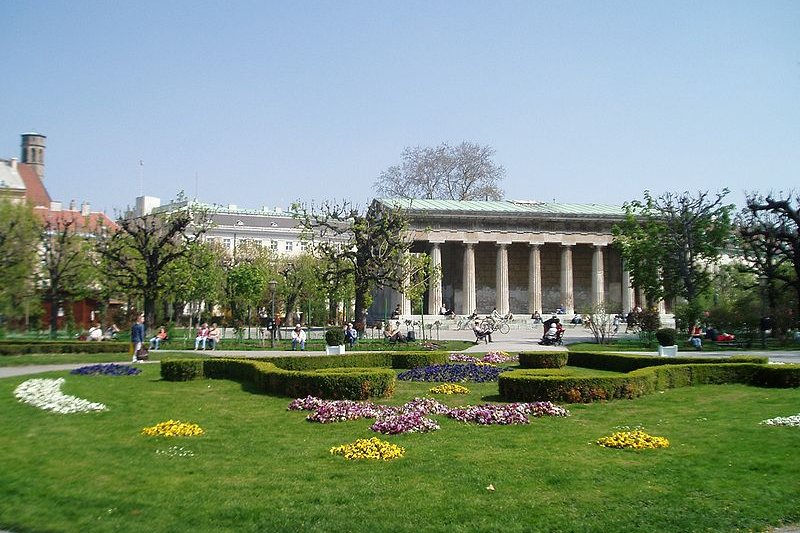 Volksgarten in Vienna
Volksgarten in ViennaSource: https://commons.wikimedia.org/wiki/File:Volksgarten.JPG
Author: Danielsp

Heldenplatz, Vienna
Heldenplatz (Heroes' Square) is a courtyard created in the 19th century as an imperial forum. It was here that in 1938 Adolf Hitler announced Austria's incorporation into the German Reich.
Alte Burg, Vienna
Alte Burg (Old Castle) is a vast Imperial Palace complex. It adjoins the Neue Burg (New Castle) which was only completed in 1913. There are seveal museums and royal apartments here.
Spanische Reitschule, Vienna
The Spanische Reitschule (Spanish Riding School) is where horses are trained to perform. Shows are held at the Winterreitschule (Winter Riding School) designed by Joseph Bernhard Fischer von Erlach.
Josefsplatz, Vienna
Josefsplatz is a square with the statue of Joseph II on horseback. Behind it is the National Library of Austria, designed by Johann Bernhard Fischer von Erlach. Its Hall of Honour (Prunksaal) is said to be the most beautiful of the libraries in Europe.
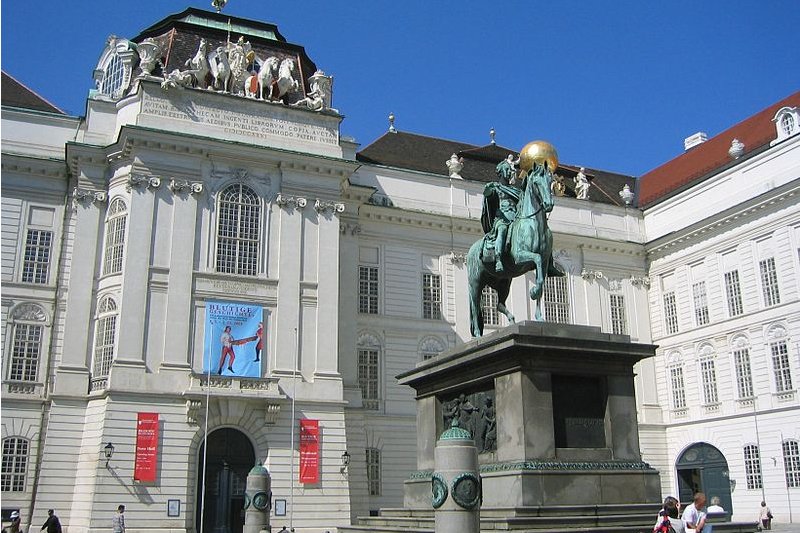 Josefsplatz in Vienna
Josefsplatz in ViennaSource: https://commons.wikimedia.org/wiki/File:Josefsplatz_Wien.jpg
Author: UrLunkwill

Augustinerkirche, Vienna
Augustinerkircher is a 14th century Gothic Augustinian church. Inside the church is the tomb to Maria Theresa's favourite daughter, Marie-Christina.
Albertina, Vienna
Albertina used to be the Habsburg palace of the Duke Albert of Sachsens-Teschen and his wife Archduchess Marie-Christina, the favourite daughter of Maria Theresa. The Historic State Room, in the Neoclassical style, is regarded as one of the best examples of Classical architecture.
Kapuzinerkirche, Vienna
The Kapuzinerkirche is on the southwestern corner of the New Market (Neuer Markt). It contains the imperial crypt (Kaisergruft), which is where Habsburg family members are laid to rest.
Stadtpalais des Prinzen Eugen, Vienna
The Stadtpalais des Prinzen Eugen is a palace built by Prince Eugene of Savoy in 1694. The architect Johann Bernhard Fischer von Erlach designed it. It houses the Ministry of Finance. Although not open to the public, visitors can look at its beautiful staircase and courtyard with Rococo fountain.
Kärntner Straße, Vienna
Kärntner Straße was once a main road in Vienna, and today a pedestrianized street with exclusive boutiques. It has several interesting sights of interest including the Church of the Knights of Malta (Malteserkirche)
New Town Hall, Vienna
The New Town Hall, or Neues Rathaus, is one of the landmarks of Vienna. It was built between 1872-1883 by Friedrich Schmidt in the Neo-Gothic style. Its central tower is 98 meters (321 feet) tall.
Parlament, Vienna
Parlament is the parliament house of Austria. The building was completed in 1883 by Dutch architect Theophil Hansen in the Neo-Classical style.
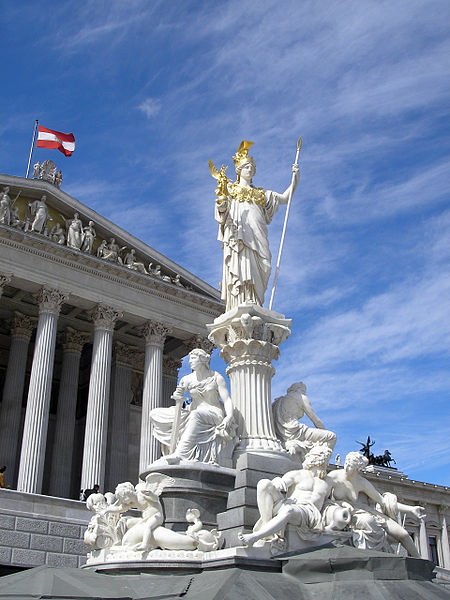 Statue of Athena in front of Parlament, the parliament building of Austria in Vienna
Statue of Athena in front of Parlament, the parliament building of Austria in ViennaSource: https://commons.wikimedia.org/wiki/File:Austria_Parlament_Athena.jpg
Author: Gryffindor

Burgtheater, Vienna
Burgtheater, one of the most prestigious theaters in the German-speaking world, was built in 1888 to replace the original structure.It was designed by Karl von Hasenauer and Gottfried Semper in the Italian Renaissance style. Although severely damaged during World War II, it was so well restored that the damage is hardly noticeable today.
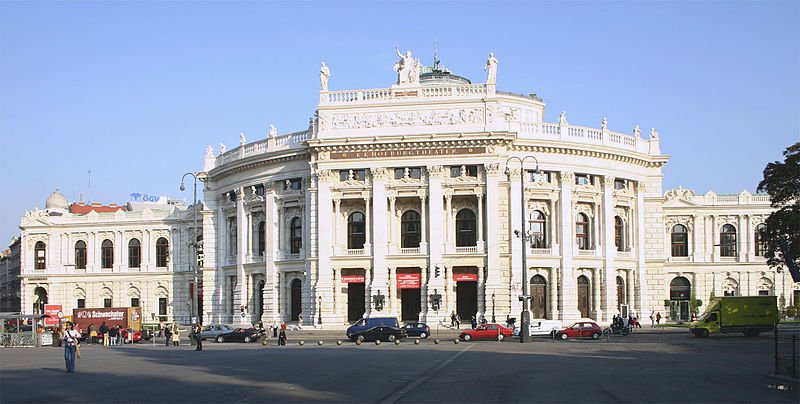 Burgtheater, Vienna
Burgtheater, ViennaSource: https://commons.wikimedia.org/wiki/File:Wien_Burgtheater.jpg
Author: Peters Gerstbach

Vienna University, Vienna
The Vienna University (Universität Wien), founded in 1365 by Rudolf IV, is the oldest university in the German-speaking world. The university building was built in 1883. It was designed by Heinrich Festel in the Italian Renaissance style.
Votivkirche, Vienna
Votivkirche is a church built in the Neo-Gothic style. It was built in 1853 with its two 99-meter (325 ft) steeples added in 26 years later. The church stands on the spot where a deranged man tried to kill Emperor Franz Joseph I.
Freud-Meseum, Vienna
Freud-Museum, at Berggasse 19, used to be the home of Sigmund Freud, the father of psychoanalysis, from 1891-1993. You can view the room where Freud received patients, the archaeological stuff he collected, among other things.
Josephinum, Vienna
Josephinum, or the Museum of the Anatomy Institute of the University of Vienna, houses life-sized anatomical models commissioned by Emperor Joseph II to teach human anatomy to surgeons.
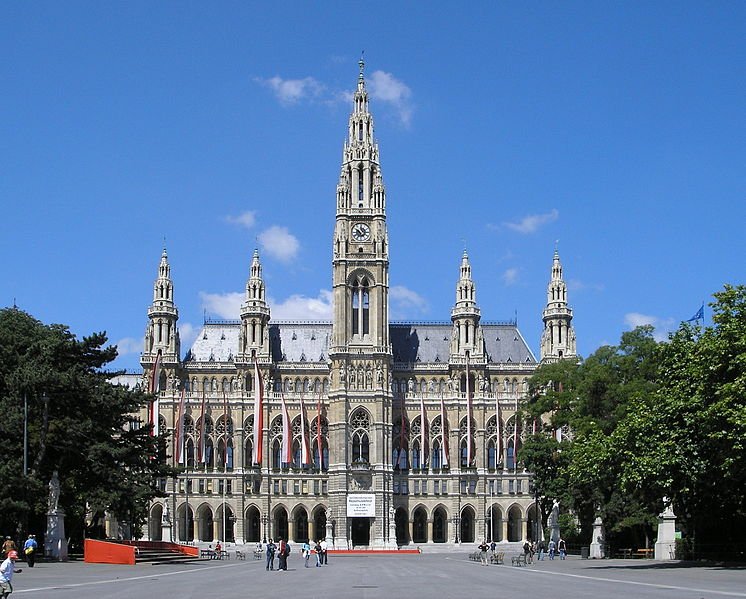 Rathaus, the City Hall of Vienna, Vienna
Rathaus, the City Hall of Vienna, ViennaSource: https://commons.wikimedia.org/wiki/File:Rathaus_Vienna_June_2006_165.jpg
Author: Gryffindor

Vienna World Heritage Site Inscription Details
Location: N 48 13 0 E 16 23 0, ViennaInscription Year: 2001, Vienna
Type of Site: Cultural, Vienna
Inscription Criteria: II, IV, VI
 Latest updates on Penang Travel Tips
Latest updates on Penang Travel Tips

Copyright © 2003-2025 Timothy Tye. All Rights Reserved.

 Go Back
Go Back